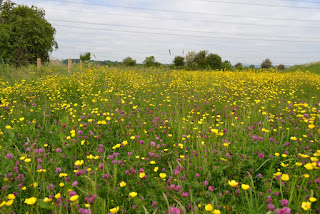|
Having
parked in central Newport
near to the railway station (which has no parking), we took a taxi to the
Newport Wetlands NNR Visitor Centre.
From here we followed the coast path west and around the perimeter of
the reserve, a power station standing between it and the mouth of the Usk. Although the OS map shows large lakes
occupying most of the reserve, these are now almost entirely reed-beds, with
only a small amount of open water.
Tufted Duck was the only water bird we saw, and there were few other
birds to be seen. There were, however,
lots of Southern Marsh-orchids and one stem of Marsh Helleborine in bud,
emerging through a dense growth of thistle, dock, Common Fleabane and Hemlock
Water-dropwort. We continued on the
path, which on the southern edge of the reserve bordered the mud and
saltmarsh of the Severn estuary. We were unable to continue along the sea-wall,
however, and the path diverts inland up a minor road to the few scattered
houses of Saltmarsh. Just before the
Nash-Goldcliff road is reached a path goes east through fields and only comes
out briefly along the road at the beginning of Goldcliff, before diverting
south through fields again to the edge of Goldcliff Pill, which it then
followed NE back into the far end of Goldcliff. The Farmers Arms pub here was closed,
although approaching lunchtime, so we continued east along the road to the
track leading through a bird reserve, Goldcliff Lagoons, composed of several
open water lakes, with hides overlooking.
We saw Lapwing here, plenty of Redshank, a few Dunlin and a lone
Turnstone. The coast path diverts east
from here to a minor road leading to the shore, where we found a private
house called Seawalls that had a rudimentary shop and sold basic food and
drink, which one could consume in an attached room, summer-house or outside
tables. In an area with no other
facilities (other than the now distant NNR visitor centre) this was welcome
and we could take a break from a cold wind and dark cloudy skies. Here the trail went to the top of the
embankment and continued there eastwards for mile after endless mile, the, at
first, vague outlines of the first Severn
bridge helping to draw us on. There
was saltmarsh of Sea Plantain, Thrift and English Scurvy-grass, but generally
the shore was plain mud, with occasional small groups of Shelduck, one group
of Oystercatchers, a lone passing Cormorant, and a Heron frightened up by our
presence from the inner ditch. For a
long time the embankment was cow-grazed and easy to walk, although with
little botanical interest, apart from some Rest-harrow and Narrow-leaved
Birdsfoot-trefoil. The day was too
windy, overcast and cool for much insect activity (only three butterflies in
total), but we came across a Drinker Moth caterpillar in the path. After we passed the smelly sewage-works
south of Urdy, the grassland management of the embankment changed somewhat,
so that there was hardly a flowering plant to be seen, and the path was
rutted by vehicles driving along, probably in connection with bird-shooting,
as private rights to this were asserted on a notice at the beginning of this
section. The only relief was a
solitary Little Egret in a saltmarsh pool.
The walk here became more of a drudge (but then we had already walked
a solid six miles of uniform embankment) and we were glad when the path
turned inland beside a sluice towards Severn Tunnel and Caldicot stations,
passing over the persistently noisy M4 motorway. From the bridge we saw that we were just
past the tollgate where we had had to queue on the way to this holiday - now
it really felt that the end was very close indeed. Although we walked to Caldicot, when we got
there we found that few trains stopped there and we had to walk back to
Severn Tunnel (only a mile away) to catch one to Newport and avoid waiting over an hour.
|
Newport Wetlands reed-marsh and power
station separating it from the Usk
Seawalls shop
Distant view of the Severn Bridge
- the goal in sight
|


















































